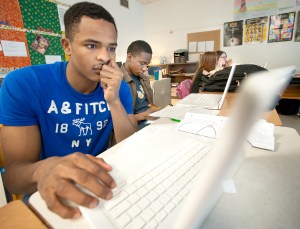LEWISTON — Freshmen English teacher Kate Friesland’s students weren’t using computers in class Tuesday.
They weren’t available.
She and three other teachers share a cart of 25 laptops for four classes. Not the best way, experts say, to teach students who’ll be using computers in the workforce.
For years, Auburn’s Edward Little High School has provided one-on-one computers to high school students. So does Poland Regional High School and Oak Hill High School in Wales.
Lisbon High School, Leavitt Area High School and Lewiston High School do not.
The Lewiston School Committee hopes to provide computers for all 1,300 high school students by the fall of 2016.
The committee will ask the Lewiston City Council to allow a $94,000 bond to provide computers to one class of students in the fall. The remaining three classes would get computers with a second $300,000 bond the following year.
The School Department will consider Chromebook laptops because they’re the most cost-effective way to go one on one, Superintendent Bill Webster said. Chromebooks cost $200 to $350.
Another reason to go with Chromebooks is the School Department is converting to Gmail next year, and schools are increasing the use of Google apps. “The Chromebook is tailored to that,” Webster said
The hope of getting computers was good news to Lewiston High School students Ryder Smith, Habbon Abdillahi, Austin Greeley, Sophie Mitchell and Muna Mohamed.
Often, computers aren’t available because other students already have them, Abdillahi said in English class Tuesday. “Even if you do get one, it might not work.”
“Technology is so important in a student’s life,” Mohamed, a student representative on the school board, said Monday night.
Students in the seventh and eighth grades have computers provided by the state. When students get to high school, not having a computer is difficult, Mohamed said, adding that many students don’t have computers at home.
Students can use computers in the library, but it closes one hour after school. “Students shouldn’t have to struggle to get their work done,” she said. “It’s hard on students. It’s a direct reason why some students lack motivation.”
Fellow student representative Sophie Mitchell agreed, saying students are required to pass in work that’s typed, and much of their schoolwork is online.
“If I didn’t have this laptop given to me by the school board, I would probably have to write on my phone. That’s what it’s like for a lot of students,” Mitchell said. “Having one-to-one computers would be very helpful; it would improve the quality of education.”
High School Technology Integrator David Theriault said teachers and students “are crying for this resource.”
Too many of the high school’s laptops are old and unreliable. He’s seen teachers put time and energy into planning lessons using technology. They sign up for a cart of laptops days ahead.
Often when the cart arrives, “nine out of 20 didn’t work or died, not because IT staff isn’t working hard,” Theriault said. “You need dependable, reliable resources.”
It’s time to provide students with computers, Theriault said. “These kids are going into the 21st-century workplace,” and every job will involve using computers. “We no longer can avoid the use of technology in our lives. These kids will be surrounded by it.”
Providing computers to high school students was in an earlier proposed budget draft but was cut because the budget was too high, Webster said.
The issue came up during budget talks, and school committee members and parents asked about providing computers to high-schoolers.
City Administrator Ed Barrett said the City Council plans to adopt a school budget May 5, then will consider bond projects on May 19 or June 2.
The list of needs for bonding is long, Barrett said, adding that the council will consider all requests.
More than half of Maine high schools provide one-on-one computers
AUGUSTA — While Maine taxpayers provide computers to every student in the seventh and eighth grade — an initiative started by former Gov. Angus King — it’s up to local districts to provide computers to high schoolers.
Throughout Maine, more than half, or 78 high schools, provide one-on-one computers as part of the Maine Learning Technology Initiative in the Department of Education, according to MLTI Policy Director Mike Muir.
More high schools provide students with one-on-one computers outside of MLTI to save money, Muir said.
Lewiston is not considering a plan as part of MLTI because the costs would be four times as high, said Superintendent Bill Webster. “The MLTI costs are out of the ballpark for Lewiston.”
Lewiston is looking at providing Chromebook laptops for a one-time cost of about $285 per student. Oak Hill High School in Wales now provides each high school student a Chromebook outside the MLTI program, Muir said.
The cost of MLTI varies from $266 a year for four years for an iPad, to $319 a year for four years for a laptop, Muir said. Those costs include the computer, case, software, maintenance, network and professional development for teachers.
Whether computers are part of MLTI or not, the Maine Department of Education endorses districts giving students access to technology in a way that is deeper than just word processing, Muir said.
“We support any district moving to a thoughtful, one-on-one plan where the focus is not just on the devices, but on teaching and learning.”


Comments are no longer available on this story